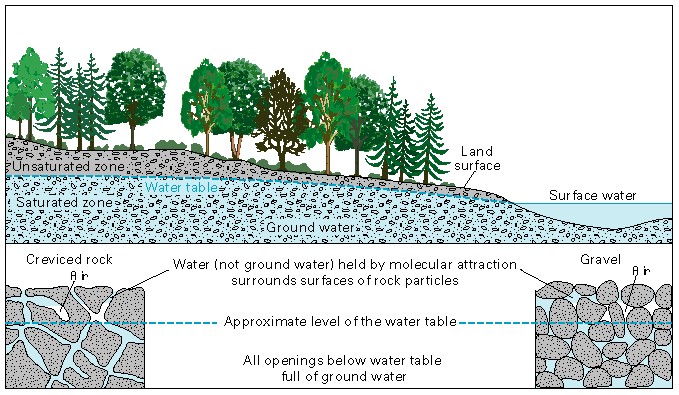Case Study 2.7: Ground Water: What Lies Beneath
It’s hard to fix what you can’t see. While much of the world’s water supply comes from the ground, it’s a resource we’ve generally paid too little attention to in the past. This case study will highlight several instances where groundwater quality and/or quantity have been impacted, look at new techniques used to track and manage this critical resource, consider some challenging policy implications related to its use, and discuss some of the difficulties faced in managing and protecting it.
Before you start, review some of the Background Materials on groundwater basics presented here.

Background Materials:
In addition to the information at the website listed in the general Water Resources section, the U.S. Geological Survey maintains several websites with useful basic information on ground water:
http://water.usgs.gov/ogw/
http://water.usgs.gov/ogw/pubs.html
California’s groundwater quality issues:the link below takes you to a good review of the nitrogen problem in California’s ground water in a report by UC Davis. It also includes some recommended steps that could help manage the problem.
http://groundwaternitrate.ucdavis.edu/files/138959.pdf
For a more detailed look at some ways to keep nitrate out of California’s ground water, visit
http://www.cropnutrition.com/keeping-nitrate-out-of-california-groundwater, a site maintained by IPNI, the International Plant Nutrition Institute.
Arsenic in Bangladesh:for some background on arsenic in ground water and the issue of well water contamination, visit a site maintained by government officials in B.C. Canada:
http://www.env.gov.bc.ca/wsd/plan_protect_sustain/groundwater/library/ground_fact_sheets/pdfs/as(020715)_fin3.pdf.
The Ogallala aquifer:for a detailed look at how local, state and federal agencies are working with non-profits and the private sector to protect the Ogallala aquifer, visit
http://www.nrcs.usda.gov/wps/portal/nrcs/detailfull/national/programs/?cid=stelprdb1048809
A useful site for information about ground water and global security is J.S. Famiglietti’s article on global ground water stress: http://www.nature.com/articles/nclimate2425.epdf?referrer_access_token=FqOXFBw46A7AKUlFJDUSndRgN0jAjWel9jnR3ZoTv0NVNoGi1gqhGrJsFbpKAZ3UinZ-Qs2rsXu6Ow5_l9kXXRLwySJpQ6cSoFMgMb1IlmJYQJHDNB3inivWstH7jHSdY6WuREjaGknuC1V2wn-Ov5eT3qWcqD3T8sjhQGSYIKQkQIErRbVoxBuDn5XHtYBgqbRE-GViC9lP0kVHHt0CHg==&tracking_referrer=thinkprogress.org
Textbook References and Links:
IPNI Guest Blog: Keeping Nitrate out of California Ground Water http://www.cropnutrition.com/keeping-nitrate-out-of-california-groundwater#sthash.8oC6Irc4.dpuf.)
Exercise 4: The International Plant Nutrition Institute nitrogen fertilizer transformation fact sheets: http://www.ipni.net/nitrogennotes
Exercise 8: Richey et al. 2015. Quantifying renewable groundwater stress with GRACE: http://onlinelibrary.wiley.com/doi/10.1002/2015WR017349/pdf
Other watershed visualizations and animations: https://www.youtube.com/watch?v=zu4cBM4m5gU
Exercise 10: Ogallala Aquifer Initiative:http://www.nrcs.usda.gov/wps/portal/nrcs/detailfull/national/programs/initiatives/?cid=stelprdb1048809
Exercise 11: Taylor 2012 review article “Ground water and climate change”:http://www.nature.com/nclimate/journal/v3/n4/full/nclimate1744.html
Exercise 12: FAO Regional Conference 2014 report: http://www.fao.org/docrep/meeting/030/mj380e.pdf
Downloadable data and files:
Exercise 8: Richey et al. 2015.pdf
Exercise 11: Taylor 2012.pdf
Exercise 12: FAO 2014.pdf


